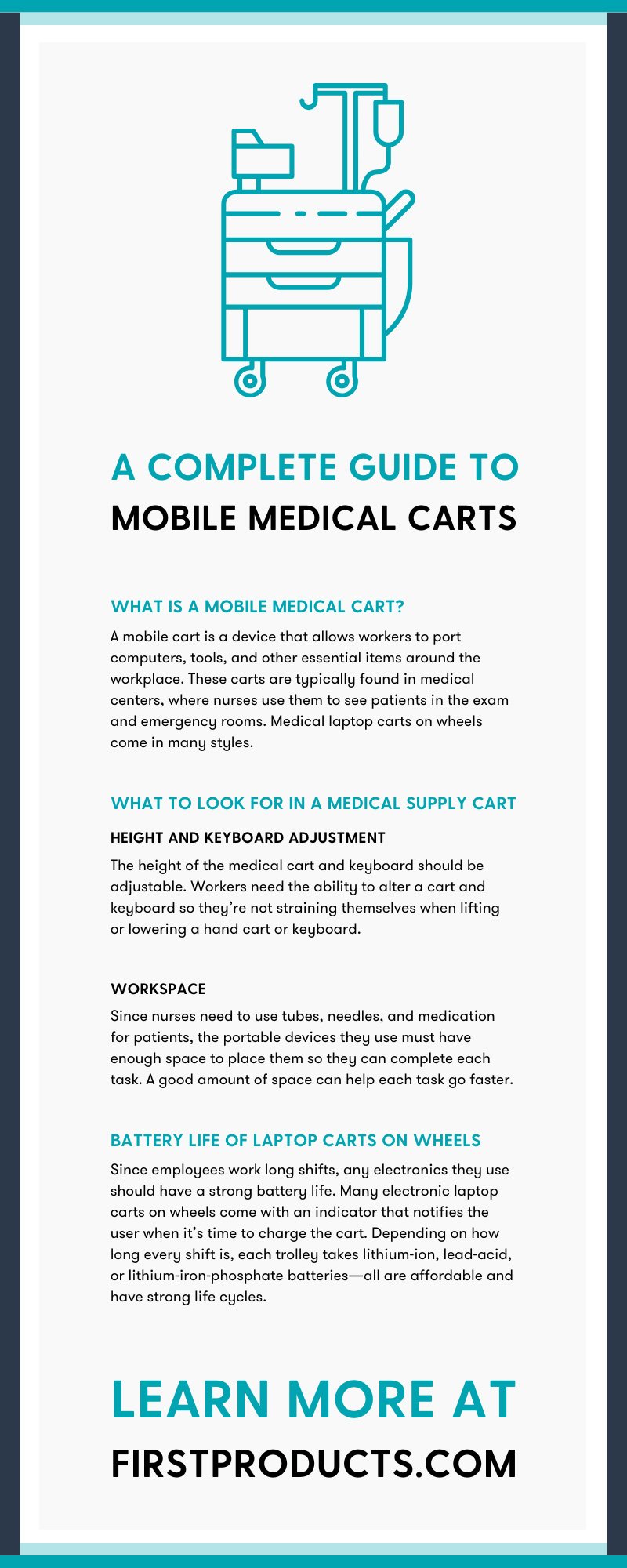By First Products on 11/14/24 2:00 PM
Clinics everywhere are modernizing, with hospitals upgrading equipment, expanding telehealth services, and improving work environments. Medical carts play a critical role in these updates, enhancing efficiency and patient care. A versatile medical cart can help streamline workflows, reduce inefficiencies, and boost your facility’s return on investment (ROI).
Our guide to mobile medical carts covers the essentials of choosing and customizing a cart that aligns with your healthcare program or branded offering.
What Is a Mobile Medical Cart?
A mobile medical cart is a wheeled device that allows healthcare staff to transport computers, tools, and medical supplies throughout a facility. Customizable and adaptable, these carts are designed to meet various medical needs, with options for different attachments, weights, and mobility features.
Why Consider the Cost-Benefit Ratio?
Investing in a high-quality medical cart offers a substantial cost-benefit ratio. A well-chosen cart can pay for itself by enhancing productivity, reducing the physical strain on staff, and ultimately improving patient care. By choosing carts with the right features, you can improve efficiency and reduce repetitive strain injuries, lowering potential costs from staff turnover and missed workdays.
Features to Look For in a Medical Cart
To optimize your program’s success, consider these essential features:
Height and Keyboard Adjustment
An ergonomic design with adjustable height and keyboard position allows staff to work comfortably, reducing strain. Traditional carts that lack adjustability can lead to musculoskeletal injuries over time. A motorized cart provides easy, strain-free adjustments for improved user comfort.
Workspace and Storage
A medical cart with ample workspace and organized storage can speed up routine tasks. Options for integrated medication stations, glove holders, and waste disposal bins help staff work more efficiently by having everything they need close at hand.
Weight and Maneuverability
Weight considerations are crucial—lightweight carts are easier to move but may need sturdier wheels to ensure stability on different surfaces. Maneuverable carts with multiple handles allow staff to navigate tight spaces easily, reducing the risk of accidents or strain.
Cable Organization
Efficient cable management prevents hazards and ensures that carts remain safe and easy to use. Look for carts with built-in cable holders to keep cords secure and out of the way.
Battery Life
Medical carts should support long shifts, so choose options with durable batteries, such as lithium-ion or lithium-iron-phosphate, that offer extended life cycles and minimize downtime. Battery life indicators add convenience, letting staff know when a recharge is due.
Compliance and Cleanability
Ensure your cart meets medical safety standards, such as EN/IEC-60601-1, for safe use around patients and devices. Also, carts made from easy-to-clean, durable materials improve hygiene and maintain compliance with hospital standards.
Optimizing Returns with a Free MotionMeter App and ROI Calculator
Measuring the ROI of your investment can reveal how much time and resources a cart saves over its lifespan. Use our free MotionMeter app to track cart usage and workflow efficiencies in real-time, allowing you to see precisely how much value a mobile cart brings to your team. Combine it with our ROI calculator to determine how quickly your investment pays off, factoring in reduced downtime, increased productivity, and minimized injury-related costs.
Reducing Inefficiencies with Customizable Carts
A custom medical cart tailored to your team’s needs can cut down inefficiencies across tasks. Imagine the time saved when a cart perfectly aligns with workflows, with features like biohazardous waste compartments, extra storage, and medication stations—each accessible exactly where and when staff need them.
Why Choose a Warranty?
Warranties offer peace of mind, covering parts and repairs for two to five years or longer, depending on the component. Whether it’s battery life or structural elements, a warranty ensures that your cart remains in top condition, maximizing its value over time.
Customizable Options for Every Need
Every healthcare program has unique requirements, and First Products can help you create a medical cart tailored to meet those needs. Customize carts with attachments for monitors, additional storage, or specialized disposal bins. Whether for an emergency room, general acute care, or a mobile telehealth program, a well-designed cart becomes an essential tool in a modernized healthcare environment.
Explore our guide to mobile medical carts and see how the right features, combined with cost-saving benefits, can make a positive impact on your healthcare program.

_11wX8.5h-FINAL.png?width=721&name=FP-Logo-Horizontal-(COLOR)_11wX8.5h-FINAL.png)


comments